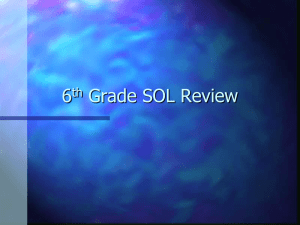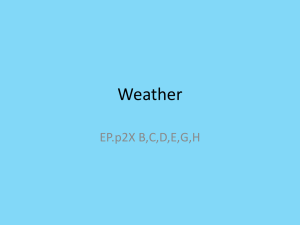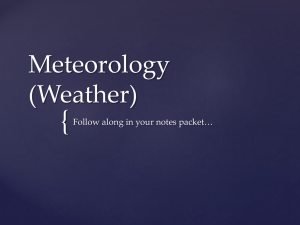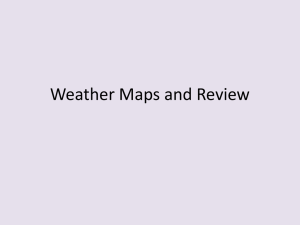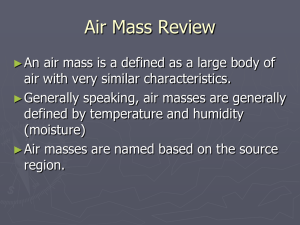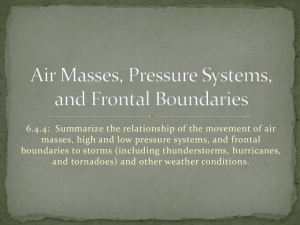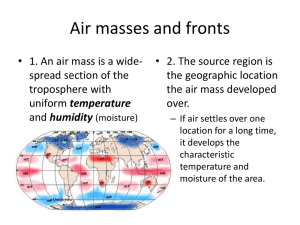Understanding weather - Rock Springs Middle School
advertisement
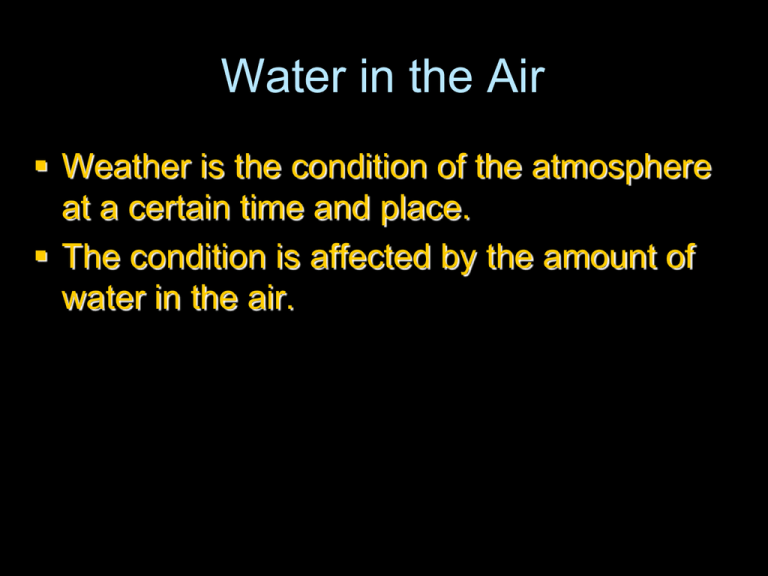
Water in the Air Weather is the condition of the atmosphere at a certain time and place. The condition is affected by the amount of water in the air. The Water Cycle Water is constantly being recycled through the water cycle. Humidity As water evaporates from lakes oceans and plants it becomes water vapor. The amount of water vapor in the air is called humidity. As the temperature increases, the amount of water vapor the air can hold increases. Relative Humidity Relative Humidity is the amount of water vapor in the air compared with the maximum amount of water vapor that the air can hold at a certain temperature Factors that affect Relative Humidity Amount of Water Vapor The more water vapor in the air the higher the relative humidity. The water vapor drops the relative humidity drops. Temperature The relative humidity decreases as the temperature rises and increases as the temperature drops Measuring Relative Humidity A psychrometer is an instrument that is used to measure relative humidity. – It consists of two thermometers: one wet bulb thermometer and one dry bulb thermometer. – The difference in the temperature readings between the two thermometers indicates the amount of humidity. Measuring Relative Humidity Condensation Condensation: the process by which a gas, such as water vapor, becomes a liquid. Condensation occurs when saturated air (air full of humidity) cools. Dew Point Dew point: the temperature at which a gas condenses into a liquid. Air is saturated at dew point Clouds A cloud is a collection of millions of tiny water droplets or ice crystals. Clouds form as warm air rises and cools Clouds Cumulus Clouds Puffy, white clouds that tend to have flat bottoms Form when warm air rises Indicate fair weather When they get larger they produce thunderstorms – cumulonimbus clouds Clouds with nimbus or nimbo will produce precipitation Stratus Clouds Stratus Clouds form in layers Cover large areas and often block out the sun Caused by a gentle lifting of a large body of air. Nimbostratus clouds are dark stratus clouds that produce continuous rain. Fog is a stratus cloud found near the ground. Cirrus Clouds Cirrus Clouds are thin feathery white clouds found at high altitudes Cirrus clouds form when the wind is strong They can indicate a change in weather. Clouds and Altitude Clouds are classified by the altitude that they form Cloud Classification Low clouds – have no prefix – Ex. Cumulus, Stratus Middle clouds – Have the prefix alto – Ex. Altocumulus, Altostratus High clouds – Have the prefix Cirro – Ex. Cirrostratus, Cirrus Precipitation Precipitation is water in solid or liquid form that falls from the air to the Earth There are four major forms – Rain – Snow – Sleet – Hail Rain The most common form of precipitation. Rain is produced when the water droplets become a certain size. Sleet and Snow Sleet forms when rain falls through a layer of freezing air. Snow forms when temperatures are so cold that water vapor changes directly to a solid. Hail Hail are balls or lumps of ice that fall from clouds. Hail forms in cumulonimbus clouds due to updrafts freezing the water droplets. Air Masses and Fronts Changes in weather are caused by the movement and interaction of air masses. An air mass is a large body of air where temperature and moisture content are similar throughout . Air Masses Air Masses are characterized by their moisture content and temperature which is determined by the area over which the air mass forms (Source Region) Types of air masses Maritime (m) Forms over water; wet Continental ( c ) Forms over land; dry Polar ( P) Forms over polar regions; cold Tropical (T) develops over the tropics: warm Cold Air Masses Cold air masses are responsible for bringing extremely cold winters. Warm Air Masses Warm air masses bring warm air weather systems into the United States. This brings milder temperatures This can also bring severe weather during the summer months. Fronts Front: the boundary between air masses of different densities and usually different temperatures Four kinds of fronts – Cold front – Warm front – Occluded front – Stationary front Cold Fronts A cold front forms where cold air moves under warm air Move quickly and bring thunderstorms, heavy rain, or snow Cooler weather follows a cold front Warm Fronts A warm front forms where warm air moves over colder denser air Warm air replaces cold air Bring drizzly rain Followed by clear and warm weather Occluded Front An occluded front forms when a warm air mass is caught between two colder air masses This produces cold temperatures and large amounts of rain and snow. Stationary Fronts Stationary fronts form when a cold air mass meets a warm air mass. Brings many days of cloudy wet weather. Locate the 4 types of fronts on this weather map. Cold Fronts Warm Front Stationary Front Occluded Front Be a Weather Forecaster You are planning to travel to Alabama in 2 days. The high temperature there for today is 68º F. Use the map to help you predict whether the temperature in Alabama will increase, decrease, or stay the same. Explain why you think so. Weather Fronts 37 Be a Weather Forecaster There is a cold front approaching. The temperatures will probably be cooler behind the front. 38 Air Pressure and Weather Areas that have lower pressure than the surrounding areas do are called Cyclones. These areas the air masses come together and rise Air Pressure and Weather Areas that have high pressure are called anticyclones. Anticyclones are areas where the air moves apart and sinks Air Pressure and Weather By keeping track of the cyclones and anticyclones, meteorologists can predict the weather. Cyclones cause stormy weather Anticyclones bring dry clear weather Severe Weather Thunderstorms Tornadoes Hurricanes Severe weather safety Thunderstorms Thunderstorms are small intense weather systems that produce strong winds, heavy rain, lightning, and thunder. Two atmospheric conditions are needed to produce a thunderstorm: – Warm and moist air near the Earth’s surface – Unstable atmosphere Thunderstorms Cumulonimbus Clouds Lightning Lightning is an electric discharge that occurs between a positively charged area and a negatively charged area. Can occur – Between two clouds – Between Earth and a cloud – Between two parts of the same cloud Lightning When lightning strikes, energy is released. Energy is transferred to the air. Thunder is the sound that results from the rapid expansion of air along the lightning strikes. Severe Thunderstorms Can produce: – – – – – High winds Hail Flash floods Tornadoes Lightning that causes forest fires and burning down homes Tornadoes Tornadoes occur in 1% of all thunderstorms. A tornado is a small spinning column of air that has high wind speeds and low central pressure and that touches the ground. It starts as a funnel cloud that pokes through a cumulonimbus cloud. Tornadoes Tornadoes 75% of the world’s tornadoes occur in the United States. Occur in spring and early summer They average 120-180 km/h wind speed Tornado Pictures Tornado Pictures Tornado Pictures Hurricanes Hurricanes are large rotating tropical weather systems that have wind speed of at least 120km/h They are the most powerful storms on Earth. Pacific Ocean hurricanes are called: typhoons Indian Ocean hurricanes are called: cyclones Hurricane Hurricanes happen over warm tropical oceans. Hurricanes vary in size from 160 to 1500 km in diameter and can travel for thousands of kilometers. How Hurricanes form Begins as a group of thunderstorms moving over tropical ocean waters Winds traveling in different directions cause the storm to spin It gets its fuel from the contact with the warm ocean waters The hurricane continues to grow as long as it is over the moist warm source. Hurricane Hurricane Damage Very destructive Average wind speed is 120-150 km/h Can knock down trees and destroy buildings Flooding is the most destructive part.( storm surge). Weather Safety Thunderstorm Safety Lightning is attracted to tall objects Crouch down in open areas Stay away from water Tornado Safety Weather forecast: watch and warning system Watch- tornado may happen Warning- tornado has been spotted Find shelter: basement or cellar Weather Safety Weather Safety Flood Safety Weather forecast: watches and warning system Find a high place Always stay out of flood waters Hurricane Safety Watch weather updates Evacuate the area Have a disaster supply kit available with food and water Board up windows with plywood Stay indoors during the storm Weather Safety Forecasting the Weather A weather forecast is a prediction of weather conditions over the next 3 to 5 days A meteorologist is a person who observes and collects data on atmospheric conditions to make weather predictions Weather-Forecasting Technology High in the sky – Weather balloons Measure weather conditions as high as 30 km above Earth Measures temperature, air pressure, and relative humidity Meteorologists can also measure wind speed and direction by tracking the weather balloons. Weather-Forecasting Technology Weather-Forecasting Technology Measuring Air Temperature and Pressure – Thermometer: a tool used to measure air temperature – Barometer: an instrument used to measure air pressure The mercury inside a barometer rises as the air pressure increases A rising barometer reading means higher pressure and possibly clear fair weather . Decreasing barometer reading means a lower pressure and possibly bad weather. Weather-Forecasting Technology Measuring Wind Direction – Can be measured by using a windsock or wind vane Windsock: is a cone shaped cloth bag open at both ends Wind vane: is shaped like an arrow with a large tail and is attached to a pole Weather-Forecasting Technology Measuring wind speed – Anemometer: an instrument used to measure wind speed Consists of four cups connected by spokes to a pole The cups move The motion sends an electric current that measures the wind speed Weather-Forecasting Technology Weather-Forecasting Technology Radar and Satellites – Radar is used to find the location movement and amount of precipitation – Doppler Radar systems on the weather station – Weather Satellites provide the Earth images of weather systems you see on TV weather reports Weather-Forecasting Technology Weather Maps National Weather Service (NWS) and National Oceanic and Atmospheric Administration (NOAA) use information from about 1000 weather stations in the US This is information from one weather station. Reading Weather Maps 1. Which statement best describes the driving force behind all the weather on Earth, from local weather systems to large-scale storms? A.The Coriolis Effect curves the motion of wind due to the Earth's counterclockwise rotation. B.The Greenhouse Effect ensures that some of the Sun's heat is always trapped close to the Earth's surface. C.The Sun heats the atmosphere unevenly, so temperatures and pressures are constantly equalizing. D.The ocean holds the heat of the Sun more efficiently and for longer periods than land. 2.. Air masses move from areas with high pressure (such as the poles of the Earth) to areas with low pressure (the equator). The temperature and moisture of an air mass depend on where it is formed. A continental tropical air mass is _______ and _______. A.warm, moist B.cold, moist C.cold, dry D.warm, dry 3. The amount of water vapor in the air is referred to as A.precipitation. B.condensation. C.humidity. D.temperature. 1. When warm air moves over cold air, a warm front forms. The warm air tends to rise along a gentle slope above the cold air and form layers of clouds. Given this information, which of the following cloud types and weather conditions would most likely result from an incoming warm front? A.stratus clouds and drizzly rain B.cumulonimbus clouds and thunderstorms C.cumulus clouds and clear weather D.isolated cirrus clouds and clear weather 2. Wispy, thin, white clouds can be seen high in the sky on a pleasant day. Which type of clouds are these? A.stratus B.cumulonimbus C.cirrus D.altostratus 3. Sharon woke up on a sunny morning and ate breakfast. Then she looked outside and saw tall, quickly-forming clouds. The clouds looked ready to rain. When she turned on the TV, she saw just what she thought—a forecast for sudden rains. What most likely caused the change in weather? A.a warm front overtaking a cold air mass B.lack of wind C.a cold front overtaking a warm air mass D.an expanding warm air mass 1. If the collected information showed that the temperature was 10°C, there was little pressure, and the wind speed was 75 mph, what type of weather would it probably be outside? A.warm and windy B.warm and sunny C.cold and wet D.cold and windy 2. A swirling, high-speed windstorm begins over the ocean. It contains heavy rains. The wind and rain rotate around a center of low pressure. When the winds inside this tropical cyclone reach 74 mph, which of the following occurs? A.hurricane B.tropical depression C.tropical storm D.thunderstorm 3. A local barometer reading on a local weather forecast was 29.8 mm and falling. What type of weather conditions are most likely to occur? A. clear and cool B. clear and warm C. fair skies D. cloudy skies

